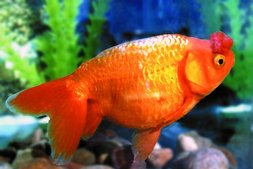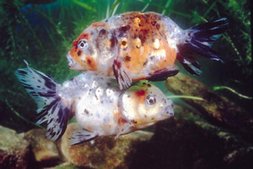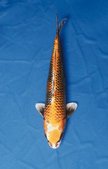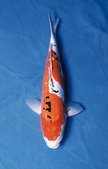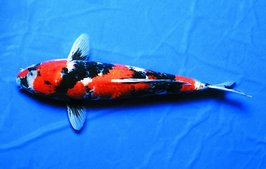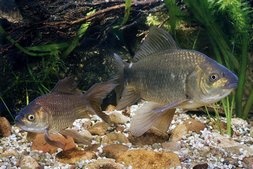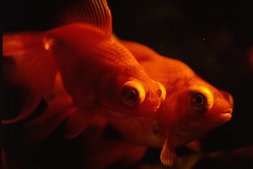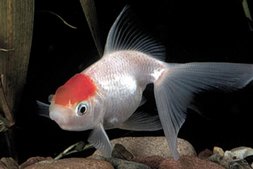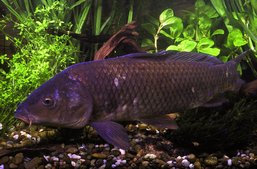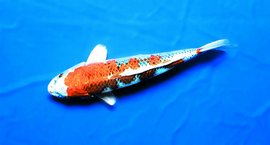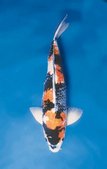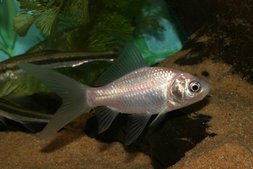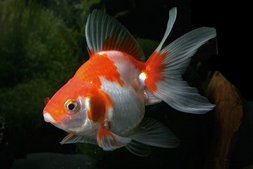Goldfishes & Koi
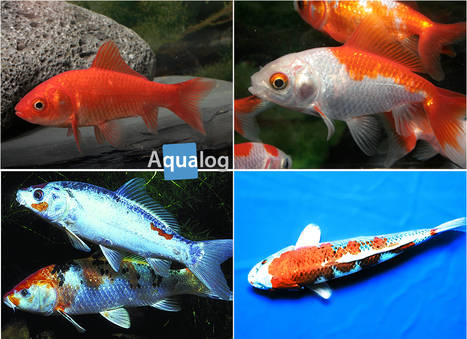
Goldfishes and Koi are the oldest ornamental fishes of all. Goldfishes have been bred in the Far East for ornamental purposes for around 1,000 years, and Koi for even longer, 1,500 years. It should be noted that this breeding was originally mainly for religious reasons. The Goldfish is a mutant of a cypriniform species that is native to China and has the scientific name Carassius auratus. The maximum length of the basic Goldfish forms is around 30-40 cm, while Veiltails and other fancy forms grow to 10-20 cm long. The Koi is a coloured cultivated form of the Common Carp, Cyprinus carpio. Hence maximum length in Koi is normally around 60 cm, with 80-90 cm being attained extremely rarely. Carp are river fishes and require a certain degree of water quality, and for this reason, and because of their size, Koi are by preference kept in ponds. By contrast, Goldfishes are members of the Crucian Carp group, which are specialised for life in small bodies of water, often with very poor water quality, and so are also very good for the aquarium. Koi and Goldfishes can easily be told apart externally by the fact that Koi have barbels at the corners of the mouth and Goldfishes don’t.
Important requirements
The long period for which these fishes have been captive-bred has produced strains that are very undemanding and well-adapted to maintenance in captivity. Goldfishes and Koi are domesticated and genetically very tame, plus they don’t readily succumb to stress. However, Koi fundamentally require clean water, a soft substrate suitable for digging, a pH between 6 and 8.5, and a lot of swimming space. Goldfishes are less demanding as regards water quality, but can otherwise be treated as for Koi. Koi and Common Goldfishes are completely winter-hardy and can be overwintered at 4 °C, while in summer they will tolerate up to 30 °C.
Appropriate feeding
Both species are omnivores. Their natural food consists of small organisms such as insect larvae, snails, small crustaceans, etc, plus decaying plant material (detritus) and soft-leaved aquatic plants. In the aquarium or garden pond they can readily be fed on all the usual frozen, live, and dry foods available in the aquarium hobby. There are also special foods for both Koi and Goldfishes available in the pet trade. Dead leaves (autumn leaves) of native deciduous trees (Beech, fruit trees, Oak, Alder, Birch, Maple, Walnut, Willow, etc) should always be available in small quantities as supplementary food, and will also provide the fishes with secondary plant substances. Like almost all fishes they should be fed several times per day with small portions that are eaten completely within five minutes. Both Goldfishes and Koi can do without food for a number of days (e.g. during holidays) without problem. At water temperatures of less than 10 °C they should not be fed at all.
Correct maintenance
In the aquarium regular large partial water changes are the most important element of maintenance. Depending on the population this can be 50% of the tank volume weekly, but in tanks with a low population density can be reduced to 25% every 14 days. The temperature of the new water should be roughly in line with that of the tank water, but up to 5°C temperature difference is nothing to worry about. The new water should always be colder, never warmer, than the aquarium water. Water changes are impracticable in the garden pond. Koi ponds require a filtration system, but well designed Goldfish ponds don’t need any equipment.
Aquarium and tankmates
Goldfishes and Koi are slow swimmers with a moderate need to move around. The bottom area of a tank for Koi should be about 8-10 times body length by 4-5 times body length. The same formula applies to the basic Goldfish types (Common, Wakin, Shubunkin, Comet), while the size can be reduced by about a third for the long-finned types (Veiltail, Ryukin, Celestial, Pearl Scale, Bubble-Eye, Oranda).
The depth of the tank will depend on the space available, but outdoor ponds should be at least a metre deep to protect the occupants from frost. Veiltail types are generally not winter-hardy in central and northern Europe. The tank decor should be Spartan: sandy substrate, rounded water-worn stones, and aquatic plants. In the case of the Goldfish forms with modified eyes (Dragon-Eyes, Celestials, Bubble-Eyes) particular care is required to ensure that the fishes don’t damage their eyes on decorative objects.
It is best to keep Koi and Goldfishes in groups though they can be kept singly. The ratio between the sexes in the group is unimportant.
Life expectancy
Koi generally live to be 30-40 years old, and there have been rumours of specimens more than 100 years of age. The maximum life expectancy depends largely on the water temperature. Specimens that are kept in warm conditions year-round never live as long as those that spend a large part of the year in winter rest. Much the same applies to Goldfishes, which usually live for 15-20 years, but are known to have attained up to 40 years of age.
Size
Koi and Goldfishes grow very rapidly during their first two summers of life. Those that are kept in warm conditions year-round are often 15-20 cm long before the end of their first year of life. Goldfishes are already sexually mature at this point, while Koi attain sexual maturity in their second year of life at the latest.
Special details
Koi with a particularly beautiful body shape and exceptional coloration fetch very high prices, while “normal” Koi are very cheap. The same applies to the fancy forms of the Goldfish. Always bear in mind that many of the specimens available in the trade come from breeders in the Tropics. These fishes won’t appreciate being put into a relatively ice-cold garden pond in the early spring. Hence the best time for populating the garden pond with such fishes is end May/ early June.





